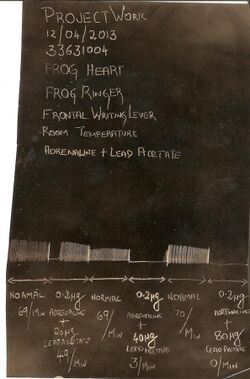Chemistry:Pharmacology of lead
Lead and other heavy metals are considered a toxin, when present in a biological system. But some ancient forms of medicine like ayurveda, siddha, Unani-tibb include mineral preparations containing heavy metals in their formulations, but its therapeutic value is contested. Heavy metals are toxic, but their oxides are not. Bhasma and rasa are formulations in the Indian system of medicines which contain heavy metals, but there toxicity is attributed to incorrect preparations.[1]
Lead intoxication
Symptoms of lead intoxication include constipation, colic, headache, vomiting, blue lines in the upper lip, jaundice, bilious tinge of the conjunctivae, bile in urine, anemia. Some neurological and muscular symptoms include lead tremor and dropped wrists.[2]
Lead acetate which was used as a sweetener, was attributed to be one of the major factors contributing to fall of the Roman Empire (not to be confused with the Holy Roman Empire).
Response of frog heart to lead
Frog heart which has the inert ability (most of the vertebrate hearts have this ability since it has its own indigenous conduction system ,which is autonomic) to continue beating even in the presence of toxicant such as chloroform, restoration is observed in strophathus, tyramine, strontium chloride, caffeine, diuretine, but one of them failed pituitrin; the most effective restoration is observed with adrenaline. Thus makes it an ideal model to assess the activity of lead on a living tissue. This experiment mainly concentrates on the frog heart being depressed by chloroform, what drugs if any are able to cause more or less restoration of the heart beat in the continued presence of chloroform. The whole experiment is done under continue perfusion of Ringer's fluid.[3]
Frog heart contraction
The contracting ability of the frog heart increases when the frog is fasted for a duration or so. Response can also be obtained on a fresh frog.The contractibility is mainly attributed to intracellular calcium signalling.[4]
References
- ↑ Singh, Reena; Gautam, Neetu; Mishra, Anurag; Gupta, Rajiv (2011). "Heavy metals and living systems: An overview" (in en). Indian Journal of Pharmacology 43 (3): 246–53. doi:10.4103/0253-7613.81505. ISSN 0253-7613. PMID 21713085. PMC 3113373. http://www.ijp-online.com/text.asp?2011/43/3/246/81505.
- ↑ "Announcement". British Journal of Surgery 78 (12): 1447. 23 November 1889. doi:10.1002/bjs.1800781213. ISSN 0007-1323.
- ↑ Ransom, Fred (1920-01-01). "The Restoration of the Frog's Heart in Chloroform Poisoning" (in en). Journal of Pharmacology and Experimental Therapeutics 14 (5): 367–377. ISSN 0022-3565. http://jpet.aspetjournals.org/content/14/5/367.
- ↑ Bagur, Rafaela; Hajnóczky, György (2017). "Intracellular Ca 2+ Sensing: Its Role in Calcium Homeostasis and Signaling". Molecular Cell 66 (6): 780–788. doi:10.1016/j.molcel.2017.05.028. ISSN 1097-2765. PMID 28622523.
Further reading
- Christopher, John Paul (1971) (in en). The Pharmacology of Lead: Environmental and Epidemiological Aspects. Department of Pharmacology, Stanford University. https://books.google.com/books/about/The_Pharmacology_of_Lead_Environmental_a.html?id=_plFAAAAIAAJ.
- Paul., Mushak (2011). Lead and public health : science, risk and regulation. Amsterdam: Elsevier. ISBN 9780080930572. OCLC 759160351.
Database
| Classification |
|---|



